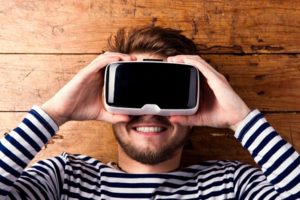6 Technology Trends from Experts at Europe’s Largest Event Tech Show
 The annual Event Tech Live show took place in London last week and it certainly was worth the visit. It is Europe’s only dedicated exhibition and conference for event professionals interested in event technology and attracts more than 1,000 attendees and 65 exhibitors from the event tech industry. The show had a great display of new technology innovations and solutions that address every aspect of the event management process. But more importantly, the conference brought together a number of high profile speakers – from technology experts to event organisers – to discuss and debate the latest technology trends that are shaping our industry today.
The annual Event Tech Live show took place in London last week and it certainly was worth the visit. It is Europe’s only dedicated exhibition and conference for event professionals interested in event technology and attracts more than 1,000 attendees and 65 exhibitors from the event tech industry. The show had a great display of new technology innovations and solutions that address every aspect of the event management process. But more importantly, the conference brought together a number of high profile speakers – from technology experts to event organisers – to discuss and debate the latest technology trends that are shaping our industry today.
From event data integration and personalised event apps to live streaming and audience engagement tools – have a look at our top takeaways from Europe’s largest event tech show:
 Integration, Integration, Integration – If there was one topic that kept coming up again and again across almost all the panel sessions, it was integration. At the event, Event Industry News and Eventsforce published their first research about data integration in the events industry which found that 60% of event planners are already integrating their event data with systems like CRM, marketing and finance solutions to save time and improve data sharing around their events. In fact, the report found that only 25% think integration is NOT a priority for them moving forwards, so we can expect a lot more of this over the coming few years.
Integration, Integration, Integration – If there was one topic that kept coming up again and again across almost all the panel sessions, it was integration. At the event, Event Industry News and Eventsforce published their first research about data integration in the events industry which found that 60% of event planners are already integrating their event data with systems like CRM, marketing and finance solutions to save time and improve data sharing around their events. In fact, the report found that only 25% think integration is NOT a priority for them moving forwards, so we can expect a lot more of this over the coming few years.
Experts also talked about integration in terms of all the different event tech organisations are using around their events – from registration systems and check-in solutions to event apps, networking tools, audience engagement, social media and so on. Keynote speaker, Scott Wilcox, South by Southwest (SXSW) Chief Innovation Officer, was arguing that more often than not, the data from all these different systems sits in silos which makes it very difficult for event planners to convert it into actionable insight. Having all these technologies as part of one integrated system not only addresses this issue but gives attendees a better event experience too. We’re all used to the Amazon experience, where we get everything in one place and get personalised recommendations based on our past activity and saved preferences. Having an integrated system with our event data can bring attendees this same level of user experience.
So, what should event planners do? Whatever event technology you’re looking to invest in, make sure that it integrates well with other solutions – whether it’s integrating with back end business systems or some of the other applications you are using around your events. If you’re interested to find more about why integration is so important for your events, have a look at this free eBook which gives event planners a comprehensive easy-to-read guide on everything they need to know about the subject, including case studies from Schroders, Haymarket, The Royal Society of Statisticians and the Liberal Democrats.
Audience Engagement – This was another topic that was broadly debated – especially with regards to what technology to use and how event planners can measure the quality of audience engagement. One thing they all agreed on that whatever engagement tool you use around your events, the technology needs to be intuitive. If you have to teach your audience members how to use it, then it’s probably not good enough. So, simplicity is key for adoption.
There were a few really good applications of engagement tools at the event itself which are worth mentioning. The first was the use of noise-cancelling ‘Silent Noize Events’ headphones by audience members which provided a perfect pick-up from the otherwise buzzing open-plan platform. The other was the use of Glisser as part of the Event Tech Live app, which is a solution that promotes engagement and audience participation at events. Attendees used the app to put questions across to panel speakers, rate other questions and see any presentation slides in real-time. It was a really useful tool to get people to engage with both the speakers and the content of the presentations – especially for those people in the audience who would typically shy away from asking questions in a typical setting. In terms of ROI, the tool also allows presenters afterwards to break down the success or shortcomings of their presentations through the software’s extensive data and analytics platform.
What Exhibitor Technology is Working – The two technology trends that seem to be dominating the exhibition sector include networking tools and anything that accurately measures the ROI of participation for exhibitors (leads, content engagement etc.). There is growing focus on the importance of proximity solutions like NFC and RFID, which are great because they aren’t reliable on Wi-Fi connectivity, which is always an issue at big events. It can also help event planners and exhibitors better understand visitor footprints on the show floor – so you can quickly identify hot and cold spots and adjust your marketing and promotional activities accordingly.
There are also the technology solutions that allow visitors to collect show content from exhibitors and share their own contact details at the same time (also known as the ‘digital handshake’). At Event Tech Live, visitors were able to use Konduko’s smart event technology that basically turns visitor badges to virtual show bags. Instead of carrying around paper brochures and flyers, attendees simply tapped their smart badges on readers installed at exhibitor stands to collect information which was emailed to them at the end of the show. The same technology was also available to download video recordings and presentations from all the panel sessions throughout the day.
 The Role of Live Streaming at Event – Live streaming has been one of the most interesting technology trends in our industry this year and its impact is set to grow, based on the investment we’re seeing pouring in – both from vendors and event planners. It is a powerful marketing tool that allows you to instantly reach out to your audiences, as well as build and engage with new ones too. We’re seeing how attendees are also up for it too. Many of them now are using their phones to share their experiences and stream events live on their social media networks through apps like Periscope, Facebook Live, Instagram Stories and Snapchat Live Stories.
The Role of Live Streaming at Event – Live streaming has been one of the most interesting technology trends in our industry this year and its impact is set to grow, based on the investment we’re seeing pouring in – both from vendors and event planners. It is a powerful marketing tool that allows you to instantly reach out to your audiences, as well as build and engage with new ones too. We’re seeing how attendees are also up for it too. Many of them now are using their phones to share their experiences and stream events live on their social media networks through apps like Periscope, Facebook Live, Instagram Stories and Snapchat Live Stories.
But will live streaming stop some people from attending your events? Many of the panelists agreed that this isn’t really the case and that event planners shouldn’t shy away from it. For each event, you may have 50% of people who can make it and another 50% who are interested but can’t and live streaming does give you the ability to reach out to this other 50%. The technology shouldn’t really affect overall numbers because people still prefer face-to-face meetings over virtual events. And don’t forget, the broader your offering, the more likely this other 50% will physically interact with your events when they’re ready to.
 The State of Virtual Reality – The technology is certainly making its mark in the industry but it would be fair to say that cost still poses as a barrier. There were some very interesting case studies of brands that have used it successfully around their events – some of which were nominated for best VR application at the Event Tech Live awards dinner that same evening. The general advice was that VR should always support and engage the visitor experience – not distract from it.
The State of Virtual Reality – The technology is certainly making its mark in the industry but it would be fair to say that cost still poses as a barrier. There were some very interesting case studies of brands that have used it successfully around their events – some of which were nominated for best VR application at the Event Tech Live awards dinner that same evening. The general advice was that VR should always support and engage the visitor experience – not distract from it.
The technology also seems to be creating new opportunities to provide better event experiences to people with disabilities (such as displaying lyrics to songs at music festivals) or to anyone who is unable to physically attend an event.
Personalised Apps – The keynote session from SWSX had a very interesting discussion exploring the emergence of the intelligent event app – a highly evolved platform that is continuously learning through the use of a recommendation engine which provides an advanced layer of personalisation. This new generation of event app gathers insight from attendee preferences, activities and location to create event experiences that meet the personalised needs of each and every attendee. For example, it will know that an attendee hasn’t booked anything for 10 o’clock on the day of the event, so the app will send a personalised message to the attendee: ‘Michael, free at 10pm? We recommend this session. Add to schedule’, with a direct link that allows them to sign up for that session.
Pushing personalised content like this that changes user behaviour and has a positive effect on the attendee’s event experience is what will determine the success of event apps in the near future.
